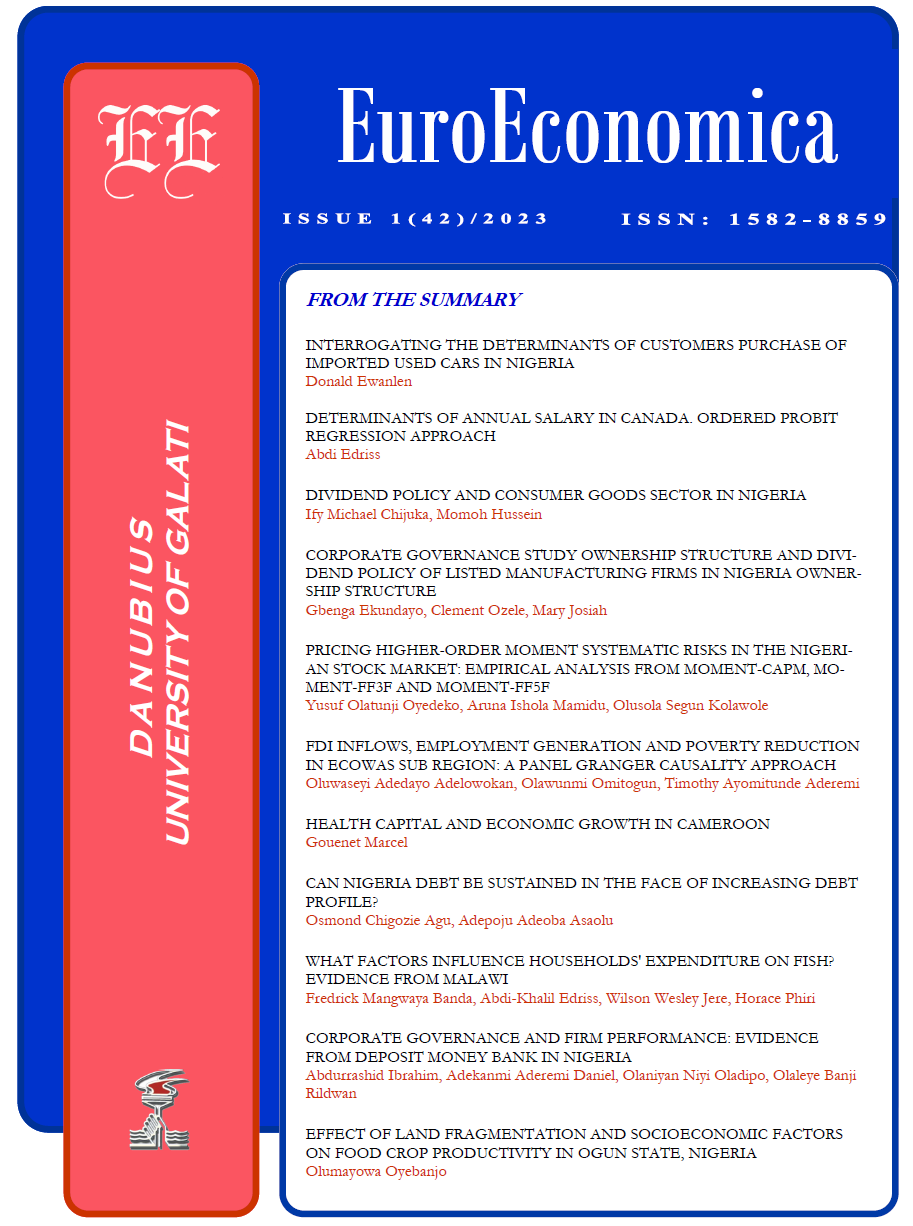Determinants Of Annual Salary In Canada
Ordered Probit Regression Approach
Keywords:
Ordered probit, annual salary, covariate, ranking, census, CanadaAbstract
Several studies provided descriptive analyses of 2016 Canadian census data; however, there are rarely advanced econometrics studies showing the relationship between ranges of annual salary and several socioeconomic, institutional, and location (or mobility) variables in Canada. A sample of 12,228 was extracted from 2016 census data. The annual salary data were grouped into seven non-overlapping homogeneous categories as outcome variables to reduce very high heterogeneity in the observations. The Ordered Probit regression underpinned the covariate analysis to understand the influence of various independent variables on annual salary for full-time employees in Canada. The prediction probability for an annual salary ranging from CDN$28,000 to 77,999 is 65.6 percent while for the CDN78,000 to 127,999 range is 32.5 percent; implying that 98.1 percent of full-time employees who completed at least high school and were aged 18 to retirement age received between minimum annual salary CDN$28,000 and maximum CDN$127,999. The remaining 2 percent received the highest salary ranging from CDN$128,000 to 400,000 during the survey. The results indicate that all age groups, ethnicity except white, residential types, education levels, household size, marital status, and all the provinces (or location) variables significantly (p-value < 0.05) influenced annual earnings; however, the magnitude and the direction (positively or negatively) of influence depends on the annual salary earning brackets.
References
REFERENCES
Burkinshaw S, Terajima Y, & Wilkins CA (2022). Income Inequality in Canada. Staff Discussion Paper. https://doi.org/https://doi.org/10.34989/sdp-2022-16
Jobillico.com. The average Canadian salary 2019. https://www.jobillico.com/blog/en/average-canadian-salary/
Maddala, GS, Lahiri K (2009). Introduction to Econometrics, 4th Edition. Wiley: New York.
McCall L. (2001). Sources of racial wage inequality in metropolitan labor markets: Racial, ethnic, and gender differences. American Sociological Review, 66(4), 520–541. https://doi.org/10.2307/3088921
Roser, M (2014, July 25). Human development index (HDI). Our World in Data. Retrieved January 15, 2023, from https://ourworldindata.org/human-development-index
Statistics Canada (2019). 2016 Census of Population [Canada] Public Use Microdata File (PUMF): Individuals File [public use microdata file]. Ottawa, Ontario: Statistics Canada [producer and distributor].
Statista. (2022). Northern Canada Average Salary Canada. https://www.statista.com/statistics/582857/median-total-family-income-northwest-territories/
Timothy D, Wheaton WC (2001). Intra-urban wage variation, employment location, and commuting times. Journal of Urban Economics, 50(2), 338–366. https://doi.org/10.1006/juec.2001.2220
United Nations Development Programme. (2022, September 8). Canada. Human Development Reports. Retrieved January 15, 2023, from https://hdr.undp.org/data-center/specific-country-data#/countries/CAN
Vejlin R (2013). Residential location, job location, and wages: Theory and Empirics. LABOUR, 27(2), 115–139. https://doi.org/10.1111/labr.12007
Wikimedia Foundation. (2022, June 2). 2016 Canadian census. Wikipedia. Retrieved January 15, 2023, from https://en.wikipedia.org/wiki/2016_Canadian_census
Wikimedia Foundation (2023, January 11). List of countries by Inequality-Adjusted Human Development index. Wikipedia. Retrieved January 15, 2023, from https://en.wikipedia.org/wiki/List_of_countries_by_inequality-adjusted_Human_Development_Index
Wikimedia Foundation (2023, January 13). Human development index. Wikipedia. Retrieved January 15, 2023, from https://en.wikipedia.org/wiki/Human_Development_Index
Wikimedia Foundation (2023, January 15). Canada. Wikipedia. Retrieved January 15, 2023, from https://en.wikipedia.org/wiki/Canada
World Bank. GINI Index for Canada [SIPOVGINICAN], retrieved from FRED, Federal Reserve Bank of St. Louis; https://fred.stlouisfed.org/series/SIPOVGINICAN, January 15, 2023.
Downloads
Published
How to Cite
Issue
Section
License
Copyright (c) 2023 Abdi Edriss

This work is licensed under a Creative Commons Attribution-NonCommercial 4.0 International License.
The author fully assumes the content originality and the holograph signature makes him responsible in case of trial.


